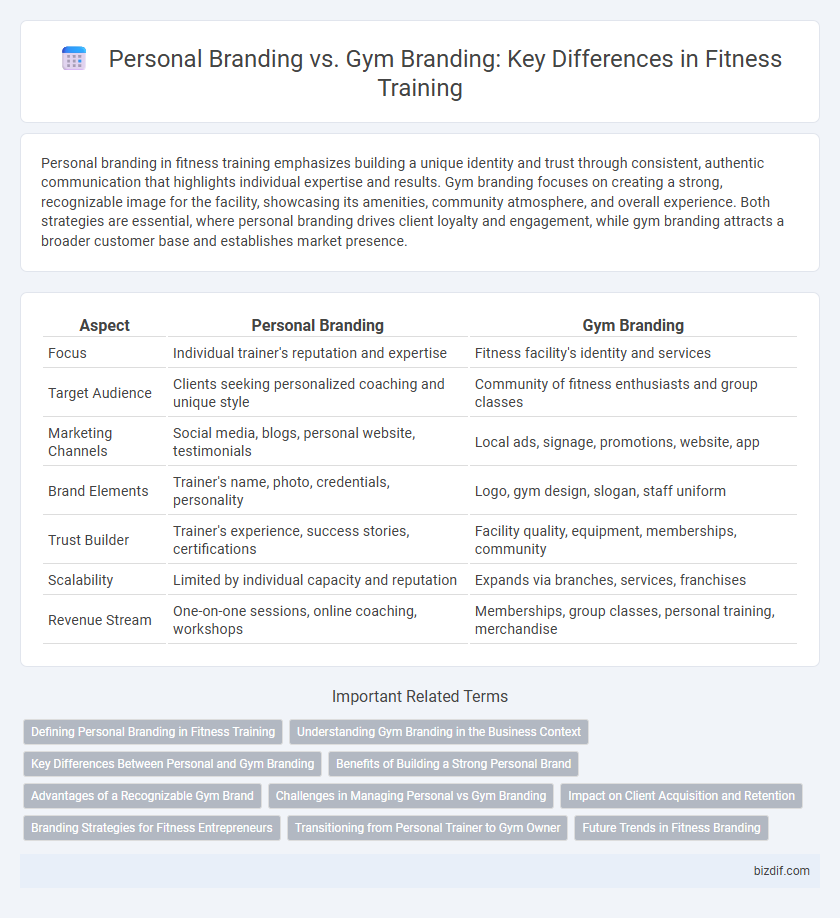Personal branding in fitness training emphasizes building a unique identity and trust through consistent, authentic communication that highlights individual expertise and results. Gym branding focuses on creating a strong, recognizable image for the facility, showcasing its amenities, community atmosphere, and overall experience. Both strategies are essential, where personal branding drives client loyalty and engagement, while gym branding attracts a broader customer base and establishes market presence.
Table of Comparison
| Aspect | Personal Branding | Gym Branding |
|---|---|---|
| Focus | Individual trainer's reputation and expertise | Fitness facility's identity and services |
| Target Audience | Clients seeking personalized coaching and unique style | Community of fitness enthusiasts and group classes |
| Marketing Channels | Social media, blogs, personal website, testimonials | Local ads, signage, promotions, website, app |
| Brand Elements | Trainer's name, photo, credentials, personality | Logo, gym design, slogan, staff uniform |
| Trust Builder | Trainer's experience, success stories, certifications | Facility quality, equipment, memberships, community |
| Scalability | Limited by individual capacity and reputation | Expands via branches, services, franchises |
| Revenue Stream | One-on-one sessions, online coaching, workshops | Memberships, group classes, personal training, merchandise |
Defining Personal Branding in Fitness Training
Personal branding in fitness training centers on establishing a unique identity that reflects an individual's expertise, values, and personality, setting trainers apart in a competitive industry. It involves consistent communication through social media, client engagement, and authentic storytelling to build trust and credibility. This approach enhances client loyalty by creating emotional connections, contrasting with gym branding that primarily promotes facilities and services.
Understanding Gym Branding in the Business Context
Gym branding in the business context involves creating a strong, recognizable identity that differentiates a fitness center from competitors through distinctive logos, color schemes, and targeted marketing strategies. Effective gym branding enhances customer loyalty by consistently communicating the gym's values, facilities, and unique offerings across digital platforms and physical spaces. Emphasizing community engagement and experience-driven services fosters trust and long-term client retention, crucial for sustainable growth in the competitive fitness industry.
Key Differences Between Personal and Gym Branding
Personal branding in fitness centers on an individual's expertise, style, and unique approach to training, creating a direct emotional connection with clients. Gym branding emphasizes the overall experience, facility quality, and community environment, targeting a broader audience through consistent visual identity and service variety. The key differences lie in personal branding's focus on authenticity and charisma, while gym branding prioritizes reputation, location, and comprehensive fitness offerings.
Benefits of Building a Strong Personal Brand
A strong personal brand in fitness training enhances trust and credibility, directly attracting dedicated clients who resonate with your unique approach and expertise. Unlike gym branding, a personal brand allows trainers to showcase their individual skills, personality, and success stories, leading to deeper client loyalty and higher retention rates. Building a personal brand also opens opportunities for collaborations, social media growth, and premium service offerings, significantly increasing income potential.
Advantages of a Recognizable Gym Brand
A recognizable gym brand builds trust and loyalty by offering a consistent experience and professional reputation, attracting a broader client base beyond individual trainers. Gym branding enables scalability through marketing campaigns, merchandise, and partnerships, increasing revenue streams and market presence. Strong gym brands also foster community and motivation, encouraging member retention and positive word-of-mouth referrals essential for sustained growth.
Challenges in Managing Personal vs Gym Branding
Managing personal branding in fitness training involves maintaining authentic, relatable content that highlights individual expertise and personality, which can be resource-intensive and emotionally demanding. Gym branding requires consistent messaging to attract diverse clientele, balancing corporate identity with local community engagement, often facing challenges in scalability and uniformity. Both demand strategic content creation, but personal branding leans on personal trust and connections, whereas gym branding prioritizes brand recognition and operational cohesion.
Impact on Client Acquisition and Retention
Personal branding in fitness training fosters a deeper emotional connection with clients, enhancing trust and loyalty, which directly increases client acquisition and retention rates. Gym branding offers broad visibility and facility appeal but often lacks the personalized touch that drives long-term client engagement. Combining strong personal and gym branding strategies maximizes market reach while maintaining individualized client relationships for sustained growth.
Branding Strategies for Fitness Entrepreneurs
Personal branding in fitness training emphasizes authentic connection, showcasing unique expertise and transformation stories to attract loyal clients. Gym branding focuses on building a recognizable identity through facility appeal, equipment quality, and community atmosphere to drive membership growth. Effective branding strategies for fitness entrepreneurs combine both personal and gym elements, leveraging digital marketing, social proof, and consistent messaging to maximize market impact.
Transitioning from Personal Trainer to Gym Owner
Transitioning from personal trainer to gym owner requires shifting focus from individual personal branding to establishing a strong gym brand identity that appeals to a broader audience. Emphasizing gym culture, facility quality, and community engagement becomes crucial for scaling business growth and client retention. Strategic marketing efforts should highlight gym services, unique offerings, and member success stories to build long-term brand loyalty.
Future Trends in Fitness Branding
Personal branding in fitness training emphasizes individual expertise, authenticity, and personalized client experiences, leveraging social media platforms and influencer partnerships to build trust and engagement. Gym branding is evolving by integrating smart technology, immersive virtual training, and community-centric spaces to enhance member retention and attract diverse demographics. Future trends highlight a hybrid approach combining personal connection with scalable gym innovations, driven by data analytics and AI to customize fitness journeys and foster long-term loyalty.
Personal Branding vs Gym Branding Infographic

 bizdif.com
bizdif.com